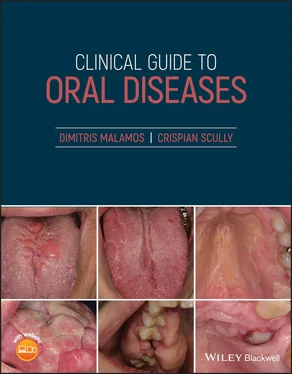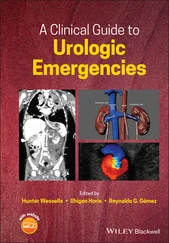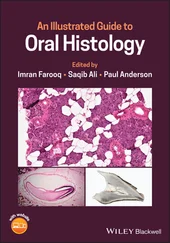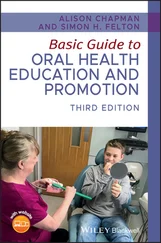3 Dry socket is characterized by an intense pain which often interferes with the patient's work or social activities in the community, thus reducing his quality of life.
4 No
5 No
Comments: Chronic local irritations and not dry socket inflammation are believed to participate in the development of some oral carcinomas. In dry socket the inflammation is acute and does not have enough time to provoke changes in the affected tissues capable for malignant transformation. Dry socket can rarely cause the spread of pathogenic bacteria into the surrounding tissues at such degree that the induced inflammation can cause pressure and dysfunction of the trigeminal nerve.
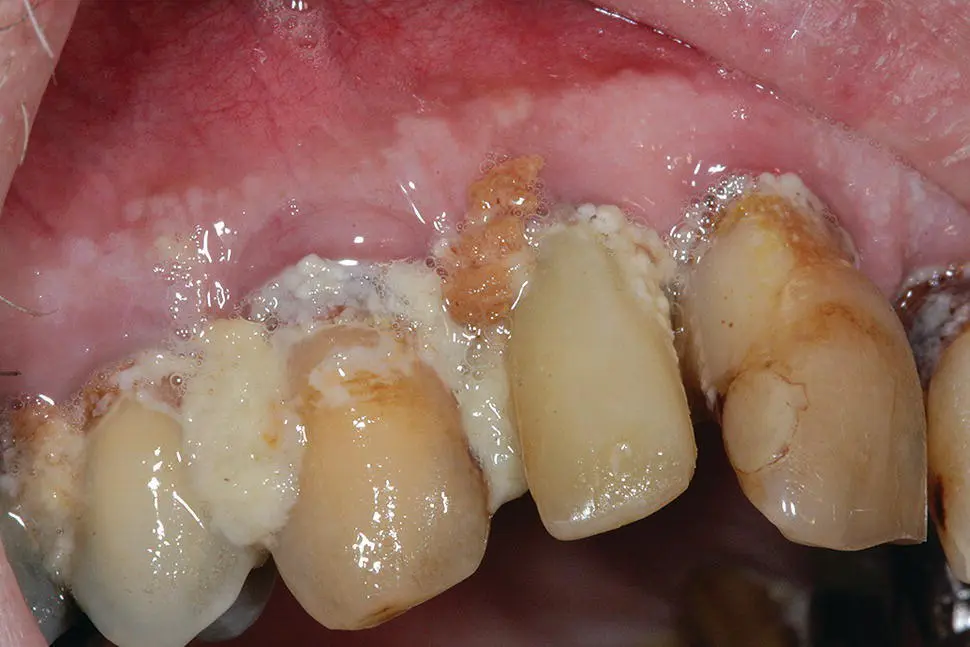
Figure 4.2
CO: A 68‐year‐old man was referred for evaluation of his dental status and his rotten breath before the beginning of zoledronic acid treatment for his lung cancer spine metastases.
HPC: His bad breath was first noticed by his clinician one month ago when the patient visited him for back pain. His halitosis was constant, worse at mornings and night, and unrelated to his meals.
PMH: His medical history revealed hypertension and respiratory problems such as chronic bronchitis and a small cell carcinoma in the left lung diagnosed two years ago which was surgically removed (lobectomy), unsuccessfully, as recent metastasis into the spine had been shown. His smoking or drinking habits had stopped since the diagnosis of his cancer.
OE: Examination revealed a cachectic man with periodontitis with gingival pockets depth from 4 to 8 mm depth forming thus a suitable place for accumulation of excessive plaque and food debris on his remaining decayed teeth ( Figure 4.2). No other oral lesions were detected. His breath was bad, rotten and repulsive. Severe pain and difficulties in posture were reported and according to his oncologist were related to his spine metastasis.
Q1What is the origin of the bad breath?
1 Smoking
2 Poor oral hygiene
3 Spine metastasis
4 Antihypertensive drugs
5 Periodontitis
Answers:
1 No
2 Anaerobic bacteria are easily found in mature dental plaque, capable of disintegrating food debris and releasing a plethora of volatile molecules which are responsible for the patient's malodor.
3 No
4 No
5 No
Comments: Smoking can cause halitosis in some patients but is not the cause here, as this habit was stopped two years ago. Spine metastasis is associated with pain and moving difficulties and spinal cord decompression, but never with halitosis. Periodontitis and some antihypertensive drugs have been related to chronic halitosis, but cannot be the cause as his bad breath was recent and detected one month ago.
Q2Which of the volatile gases is mainly responsible for the patient's halitosis?
1 Alcohol
2 Fatty acids
3 Amines
4 Sulfur compounds
5 Nicotine
Answers:
1 No
2 Volatile gases of fatty acids like butyric, valeric, and propionic acids are the result of anaerobic degradation of carbohydrates, which gives rise to oral malodor.
3 No
4 Sulfur compounds such as methyl mercaptan, hydrogen sulfide and methyl sulfide are responsible for his halitosis.
5 No
Comments: As the patient had stopped smoking or drinking for many months, his halitosis was not caused by the volatile gases released from alcohol metabolism and tobacco or its smoke‐related amines.
Q3Which of the volatile substrates has/or have sulfur components that are involved with halitosis?
1 Cysteine
2 Methionine
3 Isoleukine
4 Histidine
5 Valine
Answers:
1 Cysteine is a non‐essential sulfur containing amino acid that is found in foods with high protein content like meat and eggs. Cystine and cysteine are metabolized under the presence of sulfhydrase positive bacteria, and release H2S, a very high volatile gas.
2 Methionine and cysteine are the two sulfur containing amino acids that play an important role in halitosis (cysteine > methionine).
3 No
4 No
5 No
Comments: All the other amino acids do not have sulfur components and do not participate in sulfur production during the degradation of food debris with bacteria.
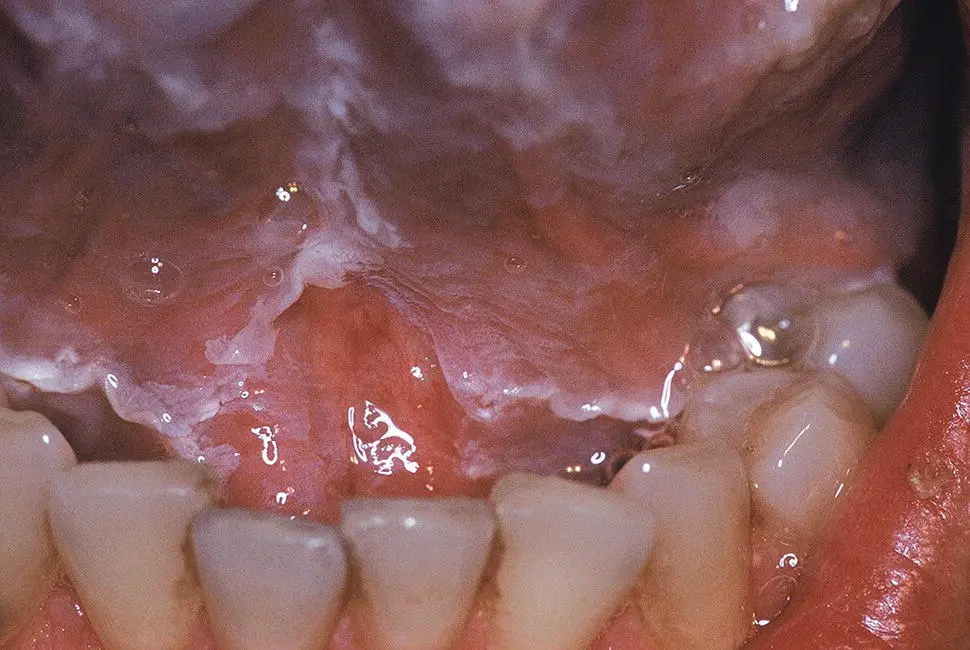
Figure 4.3
CO: A 38‐year‐old woman was referred for white oral lesions and severe halitosis of one month's duration.
HPC: The white lesions were first found by her dentist following a detailed examination before receiving a kidney transplant. Her bad breath was first noticed by her husband over a year ago, and had become more obvious over the last five months when her kidney deteriorated.
PMH: An unhealthy married woman, suffering from chronic renal failure due to recurrent episodes of pyelonephritis and hypertension, anemia, and hypercalcemia; all these conditions were partially controlled with hemodialysis and medication.
OE: A thin lady with yellow to brown skin with an edema on her face and legs, showed a number of scattered white, undetached, oral lesions on the floor of her mouth, lateral margins of tongue and buccal mucosae ( Figure 4.3). A bad smell was easily detected and had a characteristic fish‐like odor.
Q1Which disease(s) below is/are associated with this fish odor?
1 Uncontrolled diabetes mellitus
2 Intestinal obstruction
3 Kidney insufficiency
4 Phenylketonurea
5 Alcoholic ketoacidosis
Answers:
1 No
2 No
3 Kidney insufficiency is the cause. Its failure is associated with high blood and saliva urea and nitrogen concentration. Degradation of these components release a number of volatile gases causing the characteristic uremic fish‐like odor which was reinforced by the xerostomia, a common finding in patients with kidney failure.
4 No
5 No
Comments: A great number of diseases are associated with bad breath, but the type of halitosis could be an indicator of certain diseases. A fruity odor is detected among patients with diabetes I or II and in alcoholic ketoacidosis; mouse odor in phenylketonurea and fish or fecal odor are commonly accompanied with kidney diseases or intestinal obstruction respectively.
Q2Which other factors apart from urea can participate in fishy breath among patients with chronic kidney diseases (CKDs)?
1 Reduced flow rate
2 Type of dialysis treatment
3 Duration (acute vs. chronic)
4 Poor oral hygiene status
5 Electrolyte imbalance
Answers:
1 Reduced salivary flow rate (stimulated and unstimulated) is often found in CKDs. This hyposalivation allows the accumulation of sulfur producing bacteria within the mouth that are capable of producing urea, the basic component of fish odor.
2 No
3 No
4 Poor oral hygiene allows the accumulation of a number of bacteria, alters the pH of the biofilm matrix and causes tooth decay and gingival disease. All of these factors play an indirect role in halitosis production.
5 No
Comments: Halitosis is related to the severity and not to the duration or type of dialysis (peritoneal vs. hemodialysis). Electrolyte imbalance is a common finding but does not seem to play a role in halitosis.
Читать дальше
